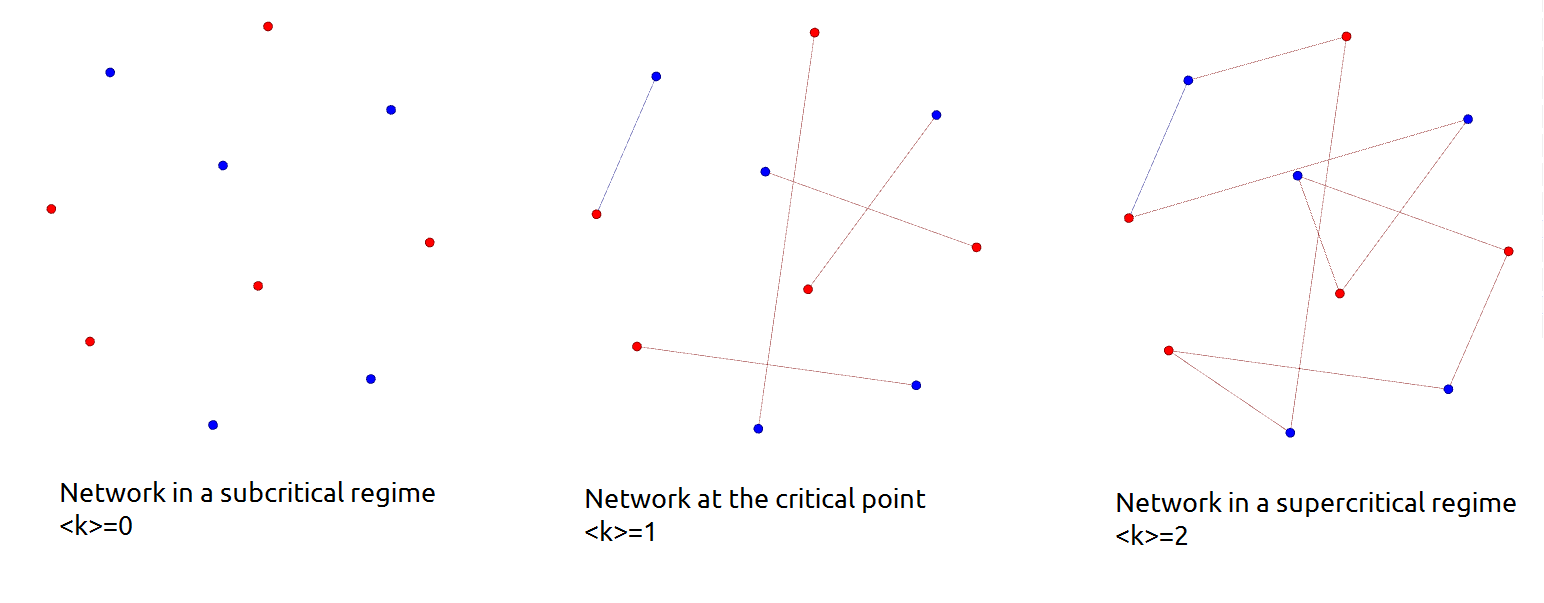Critical Point (network Science) on:
[Wikipedia]
[Google]
[Amazon]
In
 Consider a
Consider a
network science
Network science is an academic field which studies complex networks such as telecommunication networks, computer networks, biological networks, Cognitive network, cognitive and semantic networks, and social networks, considering distinct eleme ...
, a critical point is a value of average degree, which separates random networks that have a giant component
In network theory, a giant component is a connected component of a given random graph that contains a significant fraction of the entire graph's vertices.
More precisely, in graphs drawn randomly from a probability distribution over arbitrarily ...
from those that do not (i.e. it separates a network in a subcritical regime from one in a supercritical regime). Considering a random network with an average degree the critical point is
where the average degree is defined by the fraction of the number of edges () and nodes () in the network, that is .
Subcritical regime
In a subcritical regime the network has nogiant component
In network theory, a giant component is a connected component of a given random graph that contains a significant fraction of the entire graph's vertices.
More precisely, in graphs drawn randomly from a probability distribution over arbitrarily ...
, only small clusters. In the special case of the network is not connected at all. A random network is in a subcritical regime until the average degree exceeds the critical point, that is the network is in a subcritical regime as long as
.
Supercritical regime
In a supercritical regime, in contrary to the subcritical regime the network has agiant component
In network theory, a giant component is a connected component of a given random graph that contains a significant fraction of the entire graph's vertices.
More precisely, in graphs drawn randomly from a probability distribution over arbitrarily ...
. In the special case of the network is complete (see complete graph
In the mathematical field of graph theory, a complete graph is a simple undirected graph in which every pair of distinct vertices is connected by a unique edge. A complete digraph is a directed graph in which every pair of distinct vertices i ...
). A random network is in a supercritical regime if the average degree exceeds the critical point, that is if
.
Example on different regimes
 Consider a
Consider a speed dating
Speed dating is a formalized matchmaking process with the purpose of encouraging eligible singles to meet new potential partners in a very short period of time, so that interested pairs can continue meeting each other after the event.
Organiz ...
event as an example, with the participants as the nodes of the network. At the beginning of the event, people do not know anyone else. In this case the network is in a subcritical regime, that is, there is no giant component
In network theory, a giant component is a connected component of a given random graph that contains a significant fraction of the entire graph's vertices.
More precisely, in graphs drawn randomly from a probability distribution over arbitrarily ...
in the network (even if there are a couple of people, who know each other). After the first round of dates, everyone knows exactly one other person. There is still no giant component in the network, the average degree is , that is, everyone knows one other person on average, meaning that the network is at the critical point. After the second round, the average degree of the network exceeds the critical point, and the giant component
In network theory, a giant component is a connected component of a given random graph that contains a significant fraction of the entire graph's vertices.
More precisely, in graphs drawn randomly from a probability distribution over arbitrarily ...
is present. In this specific case, the average degree is . The network is in a supercritical regime.
See also
*Graph theory
In mathematics and computer science, graph theory is the study of ''graph (discrete mathematics), graphs'', which are mathematical structures used to model pairwise relations between objects. A graph in this context is made up of ''Vertex (graph ...
* Percolation theory
In statistical physics and mathematics, percolation theory describes the behavior of a network when nodes or links are added. This is a geometric type of phase transition, since at a critical fraction of addition the network of small, disconnected ...
* Complex network
* Random graph
In mathematics, random graph is the general term to refer to probability distributions over graphs. Random graphs may be described simply by a probability distribution, or by a random process which generates them. The theory of random graphs l ...
References
{{reflist Networks Network theory